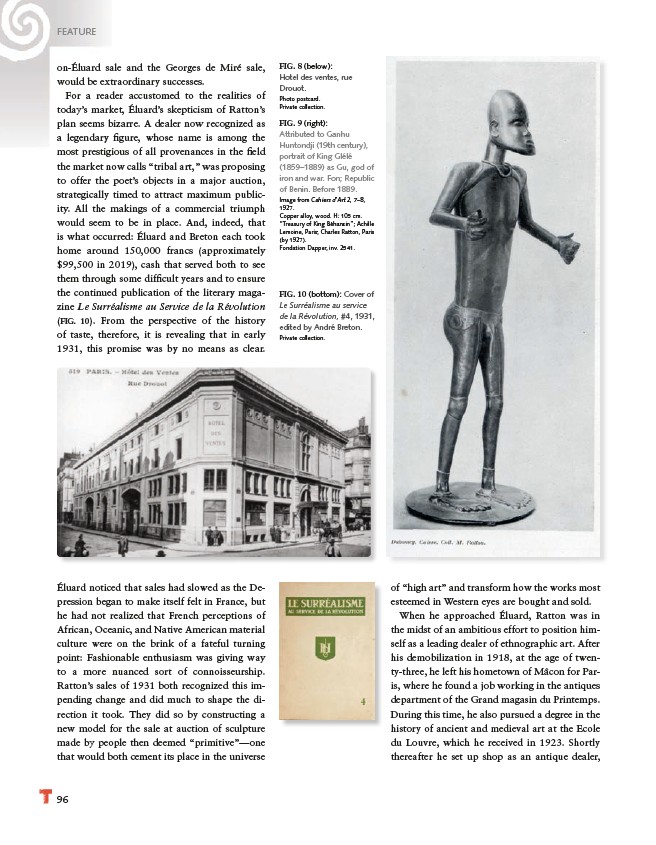
FEATURE
96
FIG. 8 (below):
Hotel des ventes, rue
Drouot.
Photo postcard.
Private collection.
FIG. 9 (right):
Attributed to Ganhu
Huntondji (19th century),
portrait of King Glélé
(1859–1889) as Gu, god of
iron and war. Fon; Republic
of Benin. Before 1889.
Image from Cahiers d’Art 2, 7–8,
1927.
Copper alloy, wood. H: 105 cm.
“Treasury of King Béhanzin”; Achille
Lemoine, Paris; Charles Ratton, Paris
(by 1927).
Fondation Dapper, inv. 2541.
FIG. 10 (bottom): Cover of
Le Surréalisme au service
de la Révolution, #4, 1931,
edited by André Breton.
Private collection.
Éluard noticed that sales had slowed as the Depression
began to make itself felt in France, but
he had not realized that French perceptions of
African, Oceanic, and Native American material
culture were on the brink of a fateful turning
point: Fashionable enthusiasm was giving way
to a more nuanced sort of connoisseurship.
Ratton’s sales of 1931 both recognized this impending
change and did much to shape the direction
it took. They did so by constructing a
new model for the sale at auction of sculpture
made by people then deemed “primitive”—one
that would both cement its place in the universe
of “high art” and transform how the works most
esteemed in Western eyes are bought and sold.
When he approached Éluard, Ratton was in
the midst of an ambitious effort to position himself
as a leading dealer of ethnographic art. After
his demobilization in 1918, at the age of twenty
three, he left his hometown of Mâcon for Paris,
where he found a job working in the antiques
department of the Grand magasin du Printemps.
During this time, he also pursued a degree in the
history of ancient and medieval art at the Ecole
du Louvre, which he received in 1923. Shortly
thereafter he set up shop as an antique dealer,
on-Éluard sale and the Georges de Miré sale,
would be extraordinary successes.
For a reader accustomed to the realities of
today’s market, Éluard’s skepticism of Ratton’s
plan seems bizarre. A dealer now recognized as
a legendary fi gure, whose name is among the
most prestigious of all provenances in the fi eld
the market now calls “tribal art,” was proposing
to offer the poet’s objects in a major auction,
strategically timed to attract maximum publicity.
All the makings of a commercial triumph
would seem to be in place. And, indeed, that
is what occurred: Éluard and Breton each took
home around 150,000 francs (approximately
$99,500 in 2019), cash that served both to see
them through some diffi cult years and to ensure
the continued publication of the literary magazine
Le Surréalisme au Service de la Révolution
(FIG. 10). From the perspective of the history
of taste, therefore, it is revealing that in early
1931, this promise was by no means as clear.